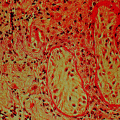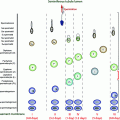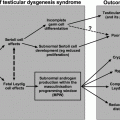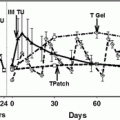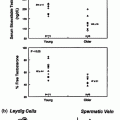Drug
Trade name
Application
Dose
Human chorionic gonadotropin (hCG)
Brevactid®a
Pregnylb
Novarelb
s.c. or i.m.
1000–2500 IU twice weekly (on Mondays and Fridays)
Recombinant FSH (rFSH)
Gonal F®a, Puregon®a
Follistimb
s.c. or i.m.
75–150 IU three times weekly (on Mondays, Wednesdays, Fridays)
Pulsatile GnRH
LutrePulse®
Mini-pump s.c.
4–20 µg per pulse every 120 min
Human chorionic gonadotropin (hCG) purified from the urine of pregnant women has been used to replace LH since 1952 [12]. It contains almost exclusively LH-like bioactivity [13], and effectively stimulates testosterone production by Leydig cells.
Follicle–stimulating hormone (FSH) is required for spermatid maturation (spermiogenesis) during initiation and for maintenance of quantitatively normal spermatogenesis at puberty and thereafter [2, 14, 15]. Urinary human menopausal gonadotropin (hMG) has been used as a source of FSH since 1966 [16], highly purified urinary FSH has been available since 1997/98 [17, 18] and recombinant FSH (rFSH) since 1995 [19–22]. The putative risks of transmission of prion disease from urinary-derived gonadotropin preparations have not been documented in over 50 years of use. rFSH, not being of human or animal origin, harbours no such risk; however, a minor risk of infection transmission remains, as foetal calf serum is used in the cell culture media in rFSH production [23, 24]. Currently, there are no data concerning the efficiency of recombinant LH (rLH) or recombinant chorionic gonadotropin (rCG) for stimulation of spermatogenesis in male HH patients, as these substances are licensed only for assisted reproductive techniques in women. Likewise, corifollitropin alfa, a long-acting recombinant FSH-like substance, necessitating only one injection every two weeks to achieve therapeutic levels (instead of thrice weekly FSH injections), is licensed only for use in women [25]. However, this long-acting follicle ‘FSH-CTP’ (Org 36286) [consisting of the α-subunit of human FSH and a β-subunit composed of the beta-subunit of human FSH and the C-terminus (CTP) of the β-subunit of hCG to prolong its half-life] was found to increase inhibin-B levels in hypogonadotropic males [26], but has not been studied further.
Gonadotropin treatment is generally initiated by administering hCG for 3–6 months [27] to stimulate the synthesis of testosterone (and potentially other Leydig cell products) which is the pre-requisite for spermatogenic induction. In some patients with partially preserved gonadotropin secretion, hCG alone may initiate spermatogenesis [28]. Intramuscular (i.m.), as well as subcutaneous (s.c.), hCG injections are possible, the latter allow for self-injection. If men remain azoospermic, FSH is added. To induce physiologic adult FSH levels, doses of 75–150 IU per injection are required [29]. Large studies using combined hCG/FSH treatment in adult male patients with HH are listed in Table 20.2.
Table 20.2
Studies using hCG/FSH treatment for spermatogenic induction in adults with hypogonadotropic hypogonadism
Studies using hCG/FSH treatment in more than 20 adult HH patients | Number of adult HH patients | Age (years) | Gonadotropin preparations and sequence of applications | Duration of substitution (months) mean or median (range) | Previous gonadotropin exposure (endogenous or exogenous) or previous TRT | Mean ± median (range) final single TV (ml) reached | Spermatogenesis achieved | Time to first sperm (months) from start FSH | Sperm concentr. achieved (mill/ml) mean ± SD or median (range) | Time to sperm plateau (months) |
|---|---|---|---|---|---|---|---|---|---|---|
Burgués and Calderón [17] | 60 | 18–45 | hCG → hCG + purified FSH | hCG: 1 hCG + FSH: 6 (+3) | 47 (78%) previous TRT 8 (13%) post-pubertal-onset HH 36 (60%) previous gonadotropins | 11 ± 1 | 48/60 (80%) | 47% sperm positive after 6 months combined tx | 25 ± 8 | n.a. |
European Metrodin HP study group [18] | 28 | 17–42 | hCG + purified FSH | hCG: 3–6 hCG + FSH: 18 | 11 (39%) previous TRT 4 hCG 1 hCG/MHG | 10 ± 4 | 89% after 18 month FSH | ca. 20% sperm + after 6 months combined tx | 16 ± 21 | n.a. |
Liu et al. [68] | 26 | 26–52 | hCG → hCG + rFSH or uFSH (+further cycles) | hCG: 3–6 hCG + FSH: 4 (0–10) | 26 no previous gonadotropins 9 post-pubertal HH 19 no TRT 6 with sperm at start of hCG 16 with more than one cycle | n.a. | n.a. | Median: in first cycles: 7 median in further cycles: 3.5 | 12 (0–238) | Median (± SE): 29 ± 2 |
Bouloux et al. [20] | 49 | 31 ± 7 (18–60) | hCG, hCG → hCG + rFSH | hCG: 4 hCG + FSH: ≥11 | 7 GnRH 19 hCH/FSH 8 no previous tx | 12 ± 7 | 23/49 (47%): 9/49 (18%) on hCG alone 14/30 (47%) after additional 6 months FSH | Median: 5.5 | n.a. (ca. 1–10) | ca. 10 |
Matsumoto et al. [22] | 36 | 18–55 | hCG → hCG + rFSH | hCG: 3–6 hCG + FSH: 18 | 5 hCG 2 hCG/FSH 5 GnRH 32 TRT | 15 ± 4 13 (7–28) | 22/29 (76%) | n.a.; 19/29 (65%) at 6 months | 10 ± 15 5.2 (0–70) | n.a. |
Warne et al. [21] | 100 | 16–48 | hCG → hCG + rFSH | hCG: 3–6 hCG + FSH: 18 | n.a. | 12 (15) ± 5 | 68/81 (84%) | Median: 6–9 (3–18) | n.a. (69% > 1.5) | n.a. |
Rohayem et al. [60] | 51 | 22–47 | hCG → hCG + FSH (urinary derived or purified or rFSH) | hCG: 11 ± 8 hCG + FSH: 9 ± 7 | 10 with pubertal arrest 10 post-pubertal HH 0 with previous hCG/rFSH 42 with previous TRT | 27 ± 15 | 50/51 (98%) | 9 ± 7 | 15 ± 29, 2.5 (0–156) | hCG/FSH: 24 ± 16 |
In recent years, the question has been raised whether the sequence of gonadotropin stimulation should be reversed, and replacement should begin with FSH. This notion was triggered by the hypothesis that Sertoli cells may proliferate better upon FSH stimulation if not previously exposed to testosterone [30, 31]. In a recent trial, rFSH administration for 4 months prior to the initiation of pulsatile GnRH treatment resulted in spermatogenesis in 7/7 HH patients after 24 months at which time only 4/6 subjects treated with pulsatile GnRH alone had sperm in their ejaculates [32]. The groups were too small for a definite conclusion, and larger trials are required before this regimen may become routine. It should also be remembered that in HH adolescents presenting primarily for induction of puberty, use of FSH without hCG will not stimulate testosterone secretion or induce pubertal virilisation in contrast to protocols beginning with hCG. As rFSH is costly, the sequential approach starting with hCG has also been preferred for financial reasons.
Hormone Replacement in Prepubertal-Onset HH
A treatment regimen beginning with testosterone for induction of puberty stimulates normal linear growth, pubertal virilization and psycho-sexual maturation in congenital HH. However, this traditional approach neglects testicular growth and the acquisition of fertility as components of normal puberty. The testes remain immature and small, i.e. in a prepubertal state, and spermatogenesis is not initiated. Meanwhile, there is sufficient evidence that complete male puberty, comprising pubertal virilisation in concert with testicular growth and initiation of spermatogenesis, can be successfully achieved during adolescence by replacement with gonadotropins (hCG/FSH) [7, 8, 30, 33–36] (Table 20.3).
Table 20.3
Studies using hCG/FSH in adolescent patients with HH, with assessment of puberty (incl. increase in testicular volume (TV)) and spermatogenesis
Studies using hCG/FSH in adolescent patients with HH, with assessment of puberty (incl. increase in TV) and spermatogenesis | Number of adolescent HH patients | Age (years) | Gonadotropin preparations and sequence of applications | Duration of substitution (months) | Virilisation/adult T levels achieved (%) | Mean ± median (range) final single TV (ml) reached | Spermatogenesis achieved | Time to first sperm (months) from start FSH | Sperm concentration achieved (mill/ml) mean ± SD median(range) | Time to sperm plateau (months) |
|---|---|---|---|---|---|---|---|---|---|---|
Liu et al. [7] | 3 (subset of cohort) | 16–17 | hCG/HMG | 100 | 9 ± 1 | n.a., total cohort: 80% | <5 | |||
Schopohl [8] | 9 (subset of cohort) | 18–24 | hCG/MHM | 20 ± 2 | 100 | n.a. (8–30) | n.a., total cohort: 47% | n.a., total cohort: (2–26) | 20 ± 2 | |
Barrio et al. [33] | 14 (IHH: 7 panhypopit: 7) | 13–21 | hCG + rFSH | 31 | 100 | IHH: 10 ± 4 panhypo: 15 ± 5 | 7/8 (87%) IHH: 4/5 panhypo: 3/3 | n.a. (1.5–80) | ||
Raivio et al. [30] | 14 | 10–18 | rFSH → rFSH + hCG | rFSH: 2–34 hCG + FSH: n.a. | 100 | 6 (2–37) | 6/7 (86%) | 8.5 (2.9–92) | ||
Sinsi et al. [34] | 10 (subset of cohort) | 11–25 | hCG → hCG + rFSH | hCG/rFSH: 12 (−24) | 100 | 10 (7–15) | n.a. total cohort: 81% | 29 (2.6–96) | ||
Zacharin et al. [35] | 7 (subset of cohort) | 16–22 | hCG → hCG + rFSH | hCG/rFSH: 9 | 100 | 12 ± 7 10 (5–27) | 7/7(100%) | 1.2 (0.2–15) 4.6 ± 6 after 9 months | ||
Rohayem et al. [36] | 60 A: 34 B: 26 | 14–22 | A: hCG → hCG + rFSH B: Testo → hCG → hCG + rFSH | A: hCG: 31 ± 6 hCG/FSH: 25 ± 9 B: hCG: 30 ± 7 hCG/FSH: 25 ± 9 | A: 100 B: 100 | A: 17 ± 3; 15 (8–40) B: 16 ± 3 17.5 (2–30) | A: 21/23 (91%) B: 18/19 (95%) | A: n.a. B: 11 ± 6 | A: 17 (0.2–337) 40 ± 73 B: 3.5 (0.1–158) 19 ± 38 | A: 31 ± 6 B: 30 ± 7 |
Gonadotropin treatment may be suggested for pubertal induction, even if fertility is a matter for the future. Even though rFSH is costly, normalization of testicular size and initiation of spermatogenesis at a peer-related time may positively affect body image and fertility concerns, and thus provide self-assurance and confidence for the future in teenage boys with HH [36, 37]. In addition, spermatogenesis, once driven to full maturation, can be re-stimulated much faster when fertility is desired later in life [5, 38]. Subsequent treatment with testosterone does not seem to jeopardize the outcome of later stimulation therapy [36]. This is important for prepubertal boys who are unwilling to commit to five s.c. injections per week for 2–3 years. However, some of these young patients may be more agreeable to gonadotropin stimulation once pubertal induction with testosterone is accomplished [39].
In adolescent patients with open epiphyses (i.e. with a bone age < 16 years), the dose of hCG should be escalated in small increments over the first year (until serum testosterone levels are in the normal adult range). The goal is a pubertal growth spurt and attainment of final height in the range of mid-parental expectations. Adverse effects, including severe acne or gynecomastia, can generally be avoided by this regimen. Subsequent combined hCG/rFSH replacement over two to three years is required for testicular growth and to fully activate the individual’s spermatogenic potential. Over 70% of adolescents will thereby reach normal adult testicular size, and sperm will appear in semen in over 90% of patient [35, 36].
In view of the challenging differential diagnosis of constitutional delay of puberty (CDGP), this regimen bears an important further advantage: low hCG doses have only weak suppressive effects at the hypothalamic or pituitary level; therefore, the pubertal GnRH pulse generator may activate in cases of unrecognized CDGP. Patients misdiagnosed as HH may thus be recognized if special attention to a potential rise in serum LH levels is given during the first phase of gonadotropin replacement.
In patients with lack of pubertal development but a late diagnosis of CHH in adulthood, or those with previous testosterone treatment, final height may already have been attained. In these adult men, higher initial hCG replacement doses and faster dose escalations can be applied than in HH boys with open epiphyses/immature growth plates. Success rates for spermatogenic induction in adults are slightly below those of adolescents, ranging from 65 to 90% [5, 17, 18, 40].
Treatment Protocol for Testosterone-Naïve Prepubertal Patients
A starting dose of (250−) 500 IU hCG, injected subcutaneously on Mondays and Fridays, with increments of 250–500 IU hCG per injection every 6 months, to a maximum of 3 × 2500 IU hCG s.c./week, is recommended. The aim is to achieve pubertal levels [serum testosterone ≥ 1.5 ng/ml, (5.2 nmol/l)] after approximately 6 months, and levels in the mid-normal adult range [testosterone > 3.5 ng/ml, (12 nmol/l)] by one year. rFSH (follitropin alpha) 3 × (75−)150 IU s.c./week (injected Mondays, Wednesdays and Fridays) is added when pubertal serum testosterone levels (>5.2 nmol/l) are reached. Subsequent rFSH dosage modifications above 150 IU per injection are not recommended as they do not further stimulate spermatogenesis.
Treatment Protocol for Testosterone-Virilized Adolescents with Prepubertal-Onset HH
A full hCG starting dose of 1500 IU s.c. may initially be applied twice weekly. hCG dose reduction is recommended if polycythemia, gynecomastia or excessive acne occur. If testosterone levels remain below the normal adult range (<12 nmol/l) after 6–9 months, the hCG dose can be increased by increments of 500–1000 IU per injection (to a maximum of 3 × 2500 IU s.c./week). rFSH (follitropin alpha) 3 × (75−) 150 IU is additionally injected thrice weekly after 3–6 months of hCG without subsequent dose modifications.
Hormone Replacement in Post-pubertal-Onset HH
In patients with HH acquired post-pubertally, testicular maturation has already been completed, as indicated by adult testicular size. If the patient has been gonadotropin deficient for a prolonged period, however, paused spermatogenesis may have led to a reduction in testicular volume. Hormone replacement can be initiated either with testosterone or gonadotropins. Since gonadotropins are costly, this therapeutic investment is justified only if paternity is desired. In all other cases, testosterone is the preferred modality for replacement. When stimulation therapy for fertility induction is initiated in patients with previously accomplished testicular maturation, Leydig cell response (as indicated by a rise in serum testosterone levels to the adult range) to hCG occurs within 1–3 months. In some cases this is sufficient for initiation of spermatogenesis [27]. However, prolonged treatment with hCG alone will suppress endogenous residual FSH secretion. Therefore, addition of FSH is often required. Spermatozoa appear in semen after 3–9 months of combined hCG/FSH replacement. Stimulation of spermatogenesis will not proceed further when the sperm concentration in the ejaculate reaches a plateau that is indicative of the individual’s spermatogenic capacity. Once spermatogenesis is fully activated by combined hCG/FSH replacement, sperm production may be maintained with hCG alone for several months (in patients with residual endogenous gonadotropin secretion) [41, 42].
Stay updated, free articles. Join our Telegram channel

Full access? Get Clinical Tree


